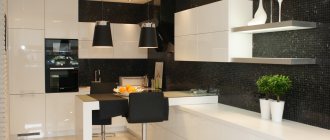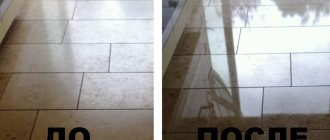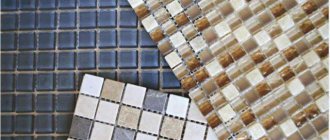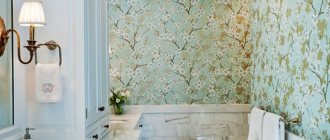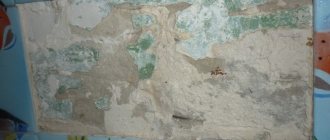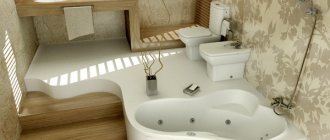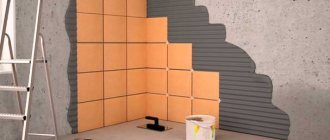Ceramic tiles have always been considered the most practical material for finishing walls in a bathroom. But what to do if the budget does not allow for finishing the entire surface with this material? Refuse to repair? Or would you prefer more budget-friendly finishing options?
Of course, budget savings will also affect the durability of the repair. Therefore, we recommend choosing the “golden mean”: combining ceramic tiles in the bathroom with painting. Let's look at different options for combining these two materials and debunk the myths associated with painted walls in the bathroom.
Tiles in wet areas
This technique is appropriate if you want to make the environment more diverse and dynamic by protecting all the “weak” points of connection between sanitary devices (sink, bathtub, toilet) with the walls.
A bathroom with tiles in wet areas performs its main function, protecting surfaces from moisture and also giving them texture. In this case, the paint occupies most of the walls, visually unifying the interior. Water-based, latex and acrylic compositions are suitable for the bathroom.
Only the shower area is tiled
This option is the most economical, since only the area above the bathtub or the surface around the shower is tiled. If you want to create an accent, choose tiles that contrast with the walls, and if you dream of a calm, enveloping interior, purchase materials that are as close in shade as possible.
Try not to skimp on paint and buy the composition specifically for the bathroom - this information is indicated on the packaging.
The area under the ceiling has been painted
For some, this technique resembles the “Soviet” version of bathroom cladding, but it still does not lose its relevance. The implementation of the idea is found in both expensive classical style and luxurious art deco.
Looks great with high ceilings and allows you to save on the amount of tiles. It is also appropriate for low ceilings, when there is about 40 cm of free space on top - the painted area looks like a frame and is complemented by moldings.
Tools and materials
When choosing a cladding material for a bathroom, you must take into account the following characteristics:
- technical parameters - strength, abrasion resistance, surface smoothness or porosity, chemical resistance. Thus, ceramic floor tiles for the bathroom should be highly wear-resistant and have a non-smooth surface;
- aesthetic parameters - color, ornament, compliance with the style of the room being designed;
- size and correct geometric shape.
Ceramic tiles come in various types, depending on the manufacturing method:
- bicottura are glazed ceramic tiles for interior wall cladding; their surface is double fired. Metlakh tiles made from quarry clay are also double fired. Not suitable for floor coverings. Glazed ceramic tiles for interior wall cladding are very durable, but their smooth surface is not suitable for laying on the floor. The exception is relief tile glaze;
- monocottura - single-firing tiles. Durable, suitable for flooring;
- the most durable tile is clinker, usually used for laying on the floor, its appearance resembles a brick;
- mosaic – small tiles glued to a mesh;
- porcelain stoneware imitating natural stone;
- glass and mirror tiles for walls and ceilings. It is subject to mechanical stress, so you cannot lay the floor with it.
Mosaic
Mirror
Clinker
Bicottura
Porcelain tiles
Monocottura
The amount of tiles is calculated as follows: you need to divide the surface area of the bathroom by the area of one element and add 10-15 percent for the margin (undercuts, defects, defects when cutting the material).
In addition to tiles, you will need the following materials:
- tile adhesive;
- primer, which should have antifungal additives;
- joint grout;
- spacers (crosses) to regulate the thickness of the joints between the tiles;
- silicone sealant;
- bathtub sealing tape;
- masking tape.
Do not forget that all materials used to make up ceramic tiles must be moisture resistant. The tools you will need are tools for applying and mixing the solution: a rubber or notched spatula for grouting, a container for primer and glue. Cutting tiles is carried out with a tile cutter, grinder or ordinary glass cutter, depending on the thickness and strength of the tile. In order to sand the edges of the tiles, you will need sandpaper. A rubber mallet is needed to tap the material so that it adheres tightly to the adhesive base. You also cannot do without a building level, a wooden strip to support the bottom row of tiles, as well as bricks, if necessary, to lay the screen space under the bathtub.
Tiles as accents
This approach helps to adjust the proportions of the room by highlighting certain areas - for example, a niche, the wall around the sink and mirror, part of the shower area.
In the interior shown in the photo, colorful tiles and matching gray paint are used: bright accents set the mood of the bathroom, increase its decorativeness and highlight what is not supposed to attract attention.
Painted walls in the bathroom and toilet: pros and cons
Pros:
1. Budget. Most likely, one time you will have to spend a lot of money on high-quality preparation of the walls. Subsequently, each new repair will cost mere pennies. At the same time, it will be possible to completely change the color and mood of the bathroom.
2. Unusual. Many people prefer tiles - from floor to ceiling throughout the entire perimeter. Therefore, painted walls in the bathroom are perceived as a very original solution.
Minuses:
1. Medium durability. Although modern paints are very durable, they cannot compare with tiles. In a bathroom with high humidity and poor ventilation, painted walls can quickly lose their appearance. Often mold and mildew form on them, cracks, stains, and peeling appear.
2. Sensitivity to mechanical influences. Painted walls should be washed gently and carefully. While with tiles, by and large, you don’t have to stand on ceremony.
3. Rustic look. Painted walls in the bathroom and toilet are very obliging. Everything should be at a fairly high level. Otherwise, the interior will look untidy and cheap.
Half of the bathroom painted
This traditional technique involves dividing the wall into two sections. With this approach, the decor looks strict and laconic, so it allows you to play with the decor. The proportions can be varied by painting a smaller or larger part of the walls.
If laid evenly, the joint need not be processed. An option is available with a frame in the form of narrow tiles or mosaics, as well as a ceramic shaped edge, appropriate in a classic style.
Only wall painted
The combination is ideal for small bathrooms and also allows you to save money. Typically, a painted wall does not come into contact with plumbing fixtures, or at most with a heated towel rail.
The color of the paint should echo the shade of the tile, its elements, or even the color of the grout: this helps bring the design together.
Since both tiles and paint are resistant to moisture, and the range of materials knows no bounds, the combination is considered ideal for the bathroom. Thanks to this, the design is not only original, but also economical.
Preliminary issues to consider
Preparation begins with calculating the number of tiles for the walls and separately for the floors. If the tiles are assumed to be monochromatic, it will be easier and faster to calculate the tiles.
If you want to decorate the bathroom in a certain style, make a drawing, draw a patterned edging around the perimeter or lay out screens, you should approach the calculations more carefully. Here it would be more correct to first draw a layout diagram.
To calculate the consumption of tiles, first calculate the area of the base. Vertical and horizontal structures require the following calculations and related points:
Determine the length and height of the walls and multiply the resulting values. The area of the doorway is subtracted from the resulting number.
Decorating bathroom walls with tiles can be done either completely or selectively. Some areas that are hidden by plumbing may not need to be repaired.
This is usually done in small apartments, where the bathrooms are so small in volume that dismantling the equipment becomes unprofitable (unless a complete replacement of the bathtub is planned). In wide bathroom spaces, dismantling and rearranging is easier.
Floors are calculated by length and width. The area of the lower horizontal base is much smaller than the walls, but here it is worth taking into account the piping and installation of the bath itself.
For many, it is enough to bring the floor tiles to the edge of the bathtub, and then install a wide vertical screen covering its side part.
We recommend reading:
Bathroom with a window: rules and real photos of successful interior solutions in 2022Gray bathroom design: pros and cons, combinations of gray with other colors
How to make your bathroom fashionable
The screen can be purchased ready-made (a panel with imitation tiles) or installed manually. Typically, brickwork or sheets of moisture-resistant plasterboard are used, followed by cladding.

